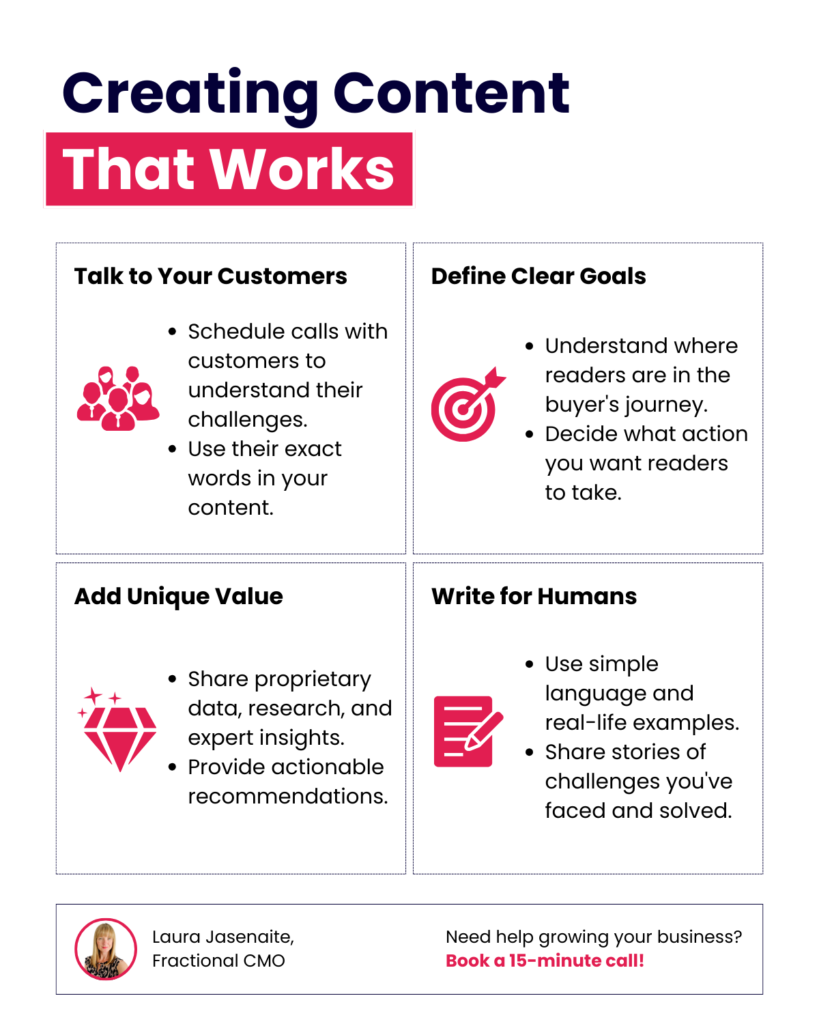Many tech companies create content that looks good on paper but fails to engage readers or drive results. The problem isn’t poor writing – it’s content that doesn’t connect with your audience or serve a clear purpose.
Let’s explore why some content falls flat and what to do about it.
The Real Problem with Tech Content
Most discussions about content quality focus on grammar, structure, and readability. But these aren’t the main issues. Content can be perfectly written and still fail to achieve its goals.
Think about the last time you read a tech company‘s blog. Did you finish the post? Did you take any action afterward? If not, the content probably suffered from one or more of these fundamental problems:
- Missing the Mark on Buyer Concerns
Your readers care about solving specific problems. When content doesn’t address these concerns, it becomes irrelevant.
Common signs your content misses the mark:
- Generic statements about “digital transformation” without specific examples
- Broad claims about “improving efficiency” without showing how
- Technical features explained without connecting to business outcomes
Instead, focus on real problems:
“How to reduce cloud computing costs by 30% while maintaining performance“
“Three ways CTOs are handling data privacy compliance in 2025″
“Case study: How Company X automated customer support without losing the human touch“
- The Echo Chamber Effect
Many tech companies produce content that merely repeats what others have said. This creates an ocean of sameness where nothing stands out.
Signs you’re stuck in the echo chamber:
- Writing about the same topics as everyone else
- Using the same examples and statistics
- Making the same general recommendations
How to break free:
- Share unique insights from your company’s experience
- Present contrary viewpoints backed by data
- Offer specific, actionable advice based on real results
- The Corporate Robot Voice
Technical writing doesn’t have to sound like it came from a machine. When content feels too formal or corporate, readers tune out.
Examples of the robot voice:
“Our solution leverages cutting-edge technology to optimise business processes”
“We utilise advanced algorithms to facilitate enhanced productivity”
“This implementation enables organisations to achieve superior outcomes”
How to sound human:
“We built this tool because our customers were wasting hours on spreadsheets“
“Here’s what we learned after analysing 1,000 customer support tickets“
“The real reason most automation projects fail (and how to avoid it)“
- Surface-Level Content That Adds No Value
With AI tools becoming more prevalent, basic “what is” and “why” content provides little value. Your readers can get surface-level information anywhere.
Signs of surface-level content:
- Defining basic terms everyone in your industry knows
- Listing obvious benefits without depth or context
- Avoiding complex topics or controversial viewpoints
How to add real value:
- Share detailed technical implementations
- Discuss trade-offs and potential pitfalls
- Provide specific examples from real projects
- Missing Strategic Purpose
Every piece of content should serve a clear business goal. Content without purpose wastes resources and confuses readers.
Signs of purposeless content:
- No clear call to action
- Disconnected from your product or service
- Unable to measure its impact
How to align content with strategy:
- Map each piece to a specific stage in your sales funnel
- Include relevant calls to action
- Track and measure results
Creating Content That Works
To fix these issues, start with these steps:
Talk to Your Customers
Schedule calls with recent customers to discuss their current challenges. Before offering your solution, ask about their struggles and take note of the exact words they use to describe them.
Define Clear Goals
What do you want readers to do after reading your content? How will you know if it’s successful? At what point in the buyer’s journey will they come across this content?
Add Unique Value
Share proprietary data and research, and include expert interviews, to offer specific and actionable recommendations.
Write for Humans
Use everyday language. Share real-life examples. Tell stories about the challenges you’ve faced and how you overcame them.
The Bottom Line
Bad content isn’t about poor writing – it’s about failing to engage readers and drive action. To create effective content, focus on addressing the real problems your buyers face. Offer them unique insights they can’t find elsewhere, speak in a human voice, and provide detailed, practical value.
Your readers are busy professionals seeking solutions to specific problems, so give them content that values their time and supports informed decision-making.
Want to create effective content? Let’s develop a content strategy that resonates with your audience and delivers results. With 20 years of experience as a Fractional CMO, I can help you define a content strategy and lead teams or external suppliers to bring it to life.
Schedule a call to discuss the challenges you’re facing and your goals.

